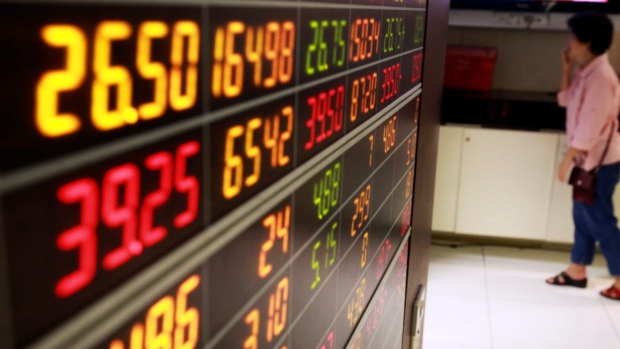Mar 19, 2018
Global stocks on longest slide since November as Fed caution hits
, Reuters

LONDON - Shares were stuck on their worst run since November on Monday, as caution gripped traders in a week in which the Federal Reserve is likely to raise U.S. interest rates and perhaps signal as many as three more hikes lie in store this year.
A near 1 per cent drop for Europe's main bourses amid a flurry of gloomy company news and weaker Wall Street futures meant MSCI's main 47-country world stocks index was down for a fifth day running.
Japan's Nikkei ended down almost 1 per cent in Asia too as its exporters were hit again by broad-based strength in the yen which was up for a third session in the last four in a lively currency market.
The dollar made ground on the euro, though, as bond traders saw the gap between 10-year German and U.S. government yields, referred to as the 'transatlantic spread', ratchet out to its widest since December 2016.
Many analysts had been expecting that spread to narrow as the ECB neared the end of its stimulus this year but it hasn't proved the case. The shorter-dated 2-year borrowing cost gap has been at its widest level in over 20 years in recent days.
"There has been the narrative of supposed policy convergence between the ECB and the Fed, but that is just not the reality," said Saxo Bank's head of FX strategy John Hardy.
With as many as four hikes seen this year, expectations were "chomping at the max" he added. "I think the euro 'longs' have good reason to be nervous," he said referring to those betting on a higher euro.
Equities markets in the rest of Asia had also struggled overnight, though China did manage to eke out some gains as Beijing announced a new economic team.
It included a surprise new central bank chief but for the most part was largely anticipated and is expected to keep the focus on halting riskier types of lending in the giant powerhouse economy.
While Wall Street had bounced on Friday, the major indices still ended lower for the week. The Dow (.DJI) lost 1.57 percent, the S&P 1.04 percent and the Nasdaq 1.27 per cent.
The decline was somewhat surprising given figures from Bank of America Merrill Lynch showed a record US$43.3 billion of inflows into equities last week, outpacing bond flows for the first time since 2013.
For the year so far, US$9.8 billion has gone into tech stocks and $7.3 billion into financials, while US$41 billion has flowed into emerging markets and $31 billion into Japan.
FED FOCUS
Whether the cash continues to flow could depend on what the Fed decides on Wednesday. All 104 analysts polled by Reuters expected the Fed would raise rates to between 1.5 perc ent and 1.75 per cent on Wednesday.
They were less certain on whether the "dot plot" forecasts of committee members will stay at three hikes this year or shift higher.
It will also be the first press conference for new Fed Chair Jerome Powell.
"Expected is a confident Fed Chair, both with respect to the economy's strength and the Fed's approach to policy," said analysts at Westpac in a note.
"While growth forecasts and the distribution of rate projections are likely to drift up, the median Fed funds forecast should remain unchanged at three in 2018 and three more in 2019," they added. "Gradual and timely are the operative words for policy."
Analysts at JPMorgan, however, see a risk the Fed might not only add one more rate rise for this year but for 2019 as well.
"The worst case is the ’18 and ’19 dots both move up - the Fed is currently guiding to five hikes in ’18 and ’19 combined but under this scenario that would shift to seven hikes," they warned in a note to clients.
"Stocks would probably tolerate one net dot increase over ’18 and ’19 but a bump in both years could create problems."
Any nod to four hikes would normally be considered as bullish for the U.S. dollar, yet the currency has shown scant correlation to interest rates in recent months, falling even as policy tightened.
Reasons cited by dealers include concerns about the U.S. budget and current account deficits, political chaos at the White House, better growth in competing countries, particularly Europe, and the risk of a U.S.-led trade war.
Trade will be top of the agenda at a two-day G20 meeting starting later on Monday in Buenos Aires and any signs of escalating stress between the U.S. and China could make investors in Asia nervous.
The cautious mood was evident in demand for the safe-haven Japanese yen which was climbing against a raft of currencies, including the euro and Australian dollar.
The U.S. dollar was off 0.3 per cent at 105.69 yen and not far from its recent trough at 105.24. It was a fraction firmer against a basket of currencies at 90.303, while the euro eased 0.2 per cent to $1.2264
The prospect of higher U.S. interest rates was been a burden for non-yielding gold, which slipped 0.8 percent last week. Early Monday, the metal was down at US1,311.20 per ounce.
Oil prices eased after ending last week with a solid bounce. Brent futures were down 40 cents at US$65.81 a barrel, while U.S. crude futures for April, which expire on Tuesday, dipped 36 cents to US$61.98 a barrel.





